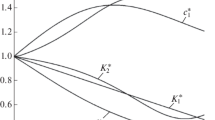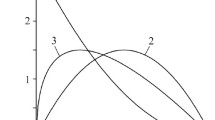We obtain a numerical-analytic solution of the thermal problem of friction for two semibounded bodies with regard for the heat sensitivity of materials and changes in the relative sliding velocity with time (braking with constant deceleration). The linearization of the corresponding boundary-value problem of heat conduction is performed by using the Kirchhoff substitution and the method of linearizing parameters. We study the changes in the temperatures of the working surfaces of the pad and the disk in the process of braking for two frictional couples with and without taking into account the temperature dependences of their thermal properties.


Similar content being viewed by others
References
G. P. Voller, M. Tirovic, R. Morris, and P. Gibbens, “Analysis of automotive disc brake cooling characteristics,” Proc. Inst. Mech. Eng., P. D: J. Automobile Eng., 217, No. 8, 657–666 (2003).
A. Adamowicz and P. Grzes, “Influence of convective cooling on a disc brake temperature distribution during repetitive braking,” Appl. Ther. Eng., 31, No. 14–15, 2177–2185 (2011).
O. V. Pereverzeva and V. A. Balakin, “The choice of thermal schemes and boundary conditions in finding nonstationary temperature fields in high-speed and heavily loaded friction units,” Tren. Iznos, 14, No. 3, 487–497 (1993).
B. É. Gurskii and A. V. Chichinadze, “Heat problem of friction and its development. Part I. Blok model and its improvement,” Tren. Iznos, 28, No. 3, 311–324 (2007).
O. O. Evtushenko and Yu. O. Pyr’ev, “Solution of the system of equations of the thermal dynamics of friction in the course of braking,” Dopov. Nats. Akad. Nauk Ukr., No. 10, 71–77 (1997).
Z. Olesiak, Yu. Pyryev, and A. Yevtushenko, “Determination of temperature and wear during braking,” Wear, 210, No. 1–2, 120–126 (1997).
A. A. Yevtushenko, E. G. Ivanyk, and O. O. Yevtushenko, “Exact formulae for determination of mean temperature and wear during braking,” Heat Mass. Trans., 35, No. 2, 163–169 (1999).
A. L. Nosko, N. S. Belyakov, and A. P. Nosko, “Application of generalized boundary condition for the solution of thermal problems of friction,” Tren. Iznos, 30, No. 6, 615–625 (2009).
A. A. Yevtushenko, M. Kuciej, and O. O. Yevtushenko, “Influence of the pressure fluctuations on the temperature in pad/disc tribosystem,” Int. Comm. Heat Mass. Trans., 37, No. 8, 978–983 (2010).
Yu. Pyryev and A. Yevtushenko, “The influence of the brakes friction elements thickness on the contact temperature and wear,” Heat Mass. Trans., 36, No. 4, 319–323 (2000).
O. O. Evtushenko and Yu. O. Pyr’ev, “Solution of the equations of the thermal dynamics of friction for a three-layer braking tribosystem,” Dopov. Nats. Akad. Nauk Ukr., No. 4, 51–56 (2000).
O. O. Evtushenko and Yu. O. Pyr’ev, “Temperature and wear of the friction surfaces of a cermet patch and metal disk in the process of braking,” Fiz.-Khim. Mekh. Mater., 36, No. 2, 55–59 (2000); English translation: Mater. Sci., 36, No. 2, 218–223 (2000.)
A. V. Chichinadze, R. M. Matveevskii, and É. D. Braun, Materials in the Triboengineering of Nonstationary Processes [in Russian], Nauka, Moscow (1986).
L. A. Kozdoba, Methods for the Solution of Nonlinear Heat-Conduction Problems [in Russian], Nauka, Moscow (1975).
Ya. I. Burak and R. M. Kushnir (editors), Modeling and Optimization in the Thermomechanics of Conducting Inhomogeneous Bodies [in Ukrainian], Vol. 3: R. M. Kushnir and V. S. Popovych, Thermoelasticity of Heat-Sensitive Bodies, Spolom, Lviv (2009).
O. Evtushenko, M. Kuciej, and E. Och, “Effect of the heat sensitivity of materials on temperature in the course of friction,” Fiz.-Khim. Mekh. Mater., 50, No. 1, 117–122 (2014).
M. Kuciej, Analytical Models of Nonstationary Frictional Heating, Oficyna Wydawnicza Politechniki Białostockiej, Białystok (2012).
A. V. Lykov, Theory of Heat Conduction [in Russian], Vysshaya Shkola, Moscow (1967).
R. B. Gundlach, “The effects of alloying elements on the elevated temperature properties of gray irons,” Trans. American Foundrymen’s Soc., 91, 389–422 (1983).
R. A. Overfelt, “Thermophysical properties of 319 aluminum, compacted graphite iron, and inconel 713,” Trans. American Foundrymen’s Soc., 109, 1–9 (2001).
S. W. Kim, K. Park, S. H. Lee, et al., “Thermophysical properties of automotive metallic brake disk materials,” Int. J. Thermophys., 29, No. 6, 2179–2188 (2008).
A. V. Chichinadze, É. D. Braun, A. G. Ginzburg, and Z. V. Ignat’eva, Numerical Analysis, Testing, and Selection of Friction Couples [in Russian], Nauka, Moscow (1979).
D. V. Hrylits’kyi, Thermoelastic Contact Problems in Tribology [in Ukrainian], Inst. Zmistu Metod. Navch. Minist. Osvity Ukrainy, Kyiv (1996).
G. R. Kirchhoff, Vorlesungen über die Theorie der Wärme, Teubner, Leipzig (1894).
M. Abramowitz and I. A. Stegun (editors), Handbook of Mathematical Functions, Dover, New York (1970).
G. A. G. Fazekas, “Temperature gradient and heat stresses in brakes drums,” Trans. SAE, 61, No. 1, 279–284 (1953).
J. H. Mathews and K. D. Fink, Numerical Methods Using МАTLAB, 3rd Edition, Prentice Hall, Princeton, NJ (1999).
O. Evtushenko, M. Kuciej, and Ol. Evtushenko, “Modeling of frictional heating in the process of braking,” Fiz.-Khim. Mekh. Mater., 48, No. 5, 27–33 (2012); English translation: Mater. Sci., 48, No. 5, 582–590 (2013).
Author information
Authors and Affiliations
Corresponding author
Additional information
Translated from Fizyko-Khimichna Mekhanika Materialiv, Vol. 50, No. 3, pp. 77–83, May–June, 2014.
Rights and permissions
About this article
Cite this article
Evtushenko, O., Kuciej, M. & Och, E. Modeling of Temperature Conditions for a Braking System with Regard for the Heat Sensitivity of Materials. Mater Sci 50, 397–405 (2014). https://doi.org/10.1007/s11003-014-9732-5
Received:
Published:
Issue Date:
DOI: https://doi.org/10.1007/s11003-014-9732-5




